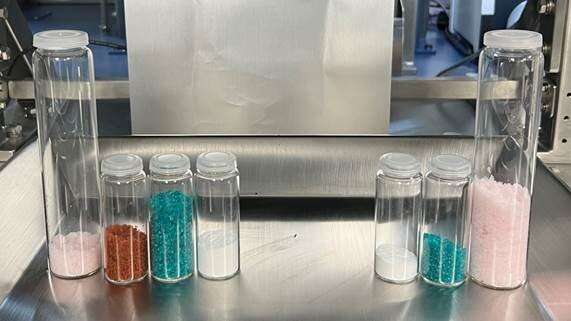This article has been reviewed according to Science X's editorial process and policies. Editors have highlighted the following attributes while ensuring the content's credibility:
fact-checked
trusted source
proofread
Three sustainable strategies to safeguard Norway's access to critical raw materials

The magnets in wind turbines come from China, and the materials in our electric car batteries are for the most part sourced from Congo. Today, key minerals and metals are being transported to Europe from politically unstable countries far away. Is it possible to safeguard access to these raw materials here in Norway? In this article, we present three research-based strategies for addressing the problem.
Minerals and critical raw materials are playing a key role in the development of renewable energy and other technologies that we need for future growth. But how, and from where, should we obtain these valuable raw materials in the future? At present, massive amounts of raw materials are being transported to Europe from the other side of the world.
"In an environmental, societal and commercial perspective, this is indefensible," says Nils Anders Røkke, who is the Norwegian science institute SINTEF's Executive Vice President for Sustainability. "Instead, we should be getting our act together and look into how we can obtain the resources here in Europe in an environmentally and climate-friendly way," he says.
Securing access and reducing dependency
Critical raw materials are defined as materials that are commercially important for global economic growth, but which also entail high levels of risk linked to access or supply. The EU operates with a list of such critical raw materials where we find metals like cobalt, lithium and the rare earth elements (REEs), among others. Access to all of these is crucial for the expected growth of green energy technologies during the next 20 years. According to the International Energy Agency (IEA), we will require 42 times more lithium than is currently being consumed, while the demand for REEs will increase by seven times. Today, our access to these materials entirely depend on import.
So how can we address these complex challenges and at the same time maintain ecological sustainability and mitigate climate change?
SINTEF is one of the research institutes that are looking into ways of meeting the growing demand for minerals and critical raw materials.
Ana Maria Martinez is a research scientist at SINTEF who works on developing innovative and environmentally friendly technologies designed to recover critical raw materials from mineral deposits (primary sources) and discarded end-of-life and by-products (secondary sources). One example is the new solar panels from solar cell waste.
In broad terms, Martinez is looking into three strategies designed to safeguard access to, and reduce our dependence on, critical raw materials:
1. More sustainable mining and extraction
China is currently the world's largest supplier of REEs, while Congo furnishes between 60 and 70 percent of the world's cobalt. Russia also extracts a large proportion of cobalt. At the same time, global climate change mitigation policies are being tightened. For example, recently introduced climate change legislation in the U.S. is creating obstacles to the EU and Norway's access to both primary minerals and manufactured batteries.
"The achievement of Europe's ambitious energy and climate mitigation targets is highly dependent on supplies of raw materials currently being imported from geopolitically unstable countries," says Martinez. "Reductions in exports of critical raw materials from these countries will put the green transition at risk. We have to increase the rates of extraction of these minerals both in Norway and Europe as a whole. We must do everything we can to achieve self-sufficiency in critical raw materials and to support the value chains in which the most important of them circulate," she says.
However, the situation is not all bad. Norway has several mineral deposits and a number of mines currently in operation, although none that are relevant to the extraction of critical raw materials. Norway also has deposits containing rare earth elements (REEs), the most important being the "FENS" field in Telemark. Further information about this deposit is available in an article published in Norwegian in the technology magazine Teknisk Ukeblad. Exploration and mapping of the FENS field is being carried out to appraise the types of minerals present and their extent. No mining is taken place at present, but the field may represent a key resource for both Norway and Europe in the future.
Mining and extraction in Norway will contribute towards meeting some of the demand for critical raw materials, but will be nowhere near sufficient to meet overall increases in need.
"The war in Ukraine has demonstrated how dependent we are on imports from politically unstable countries, how easy it is for key value chains to be seriously disrupted, and how vulnerable our European economic model is," says Martinez. "We have to identify new methods of extracting these metals that are both eco-friendly and sustainable," she says.
One solution may be to explore the deep seafloor. But this is controversial. Is it possible to recover these minerals in ways that do not harm existing ecosystems?
There are large deposits of minerals and raw materials on the seabed. The metals involved include copper and manganese, magnesium and cobalt, as well as rare earth elements such as neodymium and dysprosium, which are used to manufacture the magnets installed in wind turbines and electric vehicle engines. Further information can be found in a report published by the Norwegian Petroleum Directorate.
One thing is certain. At present we know far too little about the potential impact that seabed mining may have on climate and the environment.
"What we need is a combination of more knowledge and new technologies that will enable us to decide whether or not seabed mining is harmful to marine ecosystems," says Research Director Lars Sørum. "Preliminary sampling has demonstrated that the concentration of metals in seabed deposits is much greater than on land. If it becomes possible to extract these efficiently and sustainably, it will boost the potential for meeting the green transition's demands for valuable minerals," he says.
Less damaging than on land?
"If it emerges that the concentrations of metals in seabed deposits are as high as initial sampling suggests, and if we find out that it is possible to recover minerals from the seabed sustainably, it may prove to be the case that seabed mining can be more climate- and eco-friendly than extraction on land," says Sørum.
Expertise and technologies from the oil and gas and onshore mining industries give Norway a competitive advantage when it comes to developing climate- and eco-friendly systems for seabed mining.
SINTEF possesses broad expertise and a leading position in terms of technology development in the oil and gas sector. Know-how and technologies in the fields of drilling, processing and, not least, environmental knowledge, are some of the areas of knowledge SINTEF applies to seabed mining.
"We are currently looking into concepts that can perform mining operations in ways that are sensitive to seabed ecosystems," says Sørum. "This work will require an examination of the entire value chain. In particular, we want to look into how we can use boreholes and the return of drilled materials to enable the sensitive protection of ecosystems during extraction of the rock material," he says.
But developing this expertise will not happen overnight.
Targeted investment in research and development is required. Unfortunately, the Norwegian funding agencies are currently not optimal for this. For this reason, SINTEF is supporting the Research Council of Norway's recommendation on the need for research into seabed mining. The RCN's views on this issue can be read in its report, published in 2019: "Kunnskapsgrunnlag for forskning og teknologiutvikling på området mineralutvinning på havbunnen," in Norwegian.
2. Recycling and reuse
Since the demand for materials and minerals is so great, we need more than one leg to stand on. As well as mining from primary sources, we must also reclaim materials from secondary sources, which means recycle and reuse them. This is also announced in the Norwegian government's new mineral strategy. A current buzzword is 'urban mining."
"We must exploit our resources as best we can," says Ana Martinez. "Urban mining is all about recovering raw materials from existing end-of-life products, buildings and other waste. If we repair existing products, and recycle and reuse materials and minerals, we will be able to significantly reduce both the energy consumption and carbon footprint, and to counteract the negative impacts of primary production," she says.
A key source of rare earth elements is electronic waste. As part of the EU-financed project REEPRODUCE (GA 101057733), SINTEF's researchers are looking into how we can remove magnets from end-of-life products and recover the REEs that they contain in eco-friendly and cost-effective ways. Another approach is to investigate the fertilizer production industry, where many REEs are in circulation. The SecREEts project (GA 776559) is investigating the extraction of REEs from European sources of apatite.
"The biggest end users of REEs are industries that manufacture the magnets used in electric vehicles to make their engines more efficient. They are also used in renewable energy technology, such as in offshore wind turbines," says Martinez. "Today, Europe is entirely dependent on imports for its supplies of REEs, and there are no clear substitutes on the market. This is why it is important to establish a stable and secure European value chain for REEs," she says.

3. New products involving less or no critical raw materials
In order to minimize the carbon footprint of a new product, the raw materials used in its manufacture must be sourced as close as possible to the site of manufacture. Thus, raw materials derived from secondary sources should ideally be sourced locally. Another means of achieving our target is simply to develop new products and technologies that use less critical raw materials than at present.
"We are involved in several projects that are looking into reducing, or eliminating entirely, our dependence on critical raw materials in connection with key technologies linked to the green transition, such as batteries," says Martinez. "This involves examining the entire life cycle of the product, taking both economics and sustainability into account," she says.
"The HYDRA and InteLiGent projects are good examples. Here, more efficient, and commercially profitable batteries are being developed that are cobalt-free, and which make use of more sustainable and more easily accessible raw materials. Both of these projects are funded by the EU with the aim of developing lithium-ion batteries for electric vehicles.
"Lithium is also defined as a critical raw material, sourced for the most part from Australia and South America," says Martinez. "Even though lithium remains an essential component in lithium-ion batteries, the amounts we use can be reduced significantly either by means of smart materials selection or the application of alternative battery technologies," she says.
The Norwegian government is currently preparing a new minerals strategy with the aim of promoting development of the world's most sustainable minerals industry.
"We are well underway in terms of the know-how, methods and technology development we will need to make this possible," says Nils Anders Røkke. "However, we currently know too little about how we can recover minerals from the seabed while keeping the marine ecosystems intact. To achieve this, we will need more research and development. We need to develop technologies that can make mineral extraction possible. If we succeed, there will be major opportunities to extract minerals from the seabed," he concludes.


















